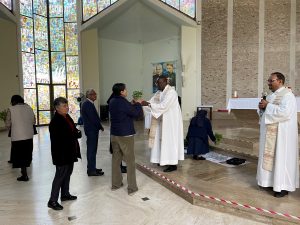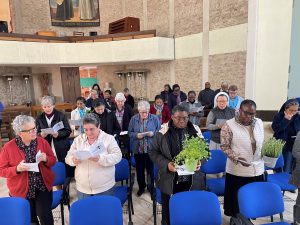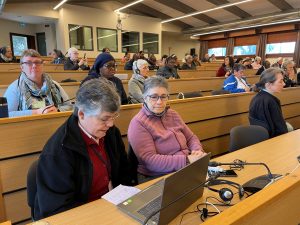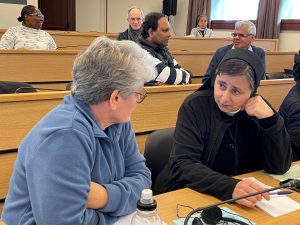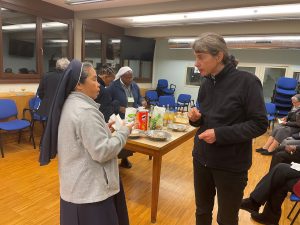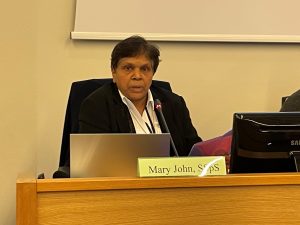 Introduction
Introduction
I am sure speakers before me have spoken on the changing demographic scenario. To treat this vast topic within manageable limits I will make my presentation with two focal points.
- What the changing landscape is inviting the global south to- the implications.
- What might be some of the pointers or future directions in the changing landscape anywhere.
In the first part, I will try to share from an Asian and women’s perspective more precisely from an Indian perspective, and in the second part from a general perspective.
World population has reached 8 billion in December 2022.
60% of the world population live in Asia.
40% of the world population live in just two countries: China (24%) and India (16%). This too is changing very soon.
90% of the world population live in the North of the Equator, and 10% in the South of the Equator.
One of the most interesting countries is India where there are more religious sisters than in any other country (16% of all the religious sisters in the world). According to CARA (Centre for applied research in the apostolate the number of sisters in 1975 in India was 41,868 and this had grown to 99,282 in 2019. The number of sisters grew during this period by 137% as the number of Catholics increased by 145%.
We are all hearing these days about the Global South becoming the new locus of missionaries and missionary activities. Given that this is a reality, how much is the South prepared to meet the demands of this changing landscape and to accommodate the shift that is taking place? What changes do we need to make in the South to adequately honour this responsibility?
I will mention a few.
- More synodality is needed. Recently I was home for two weeks in Kerala. My youngest brother is actively involved in the parish and in the management of the temporal goods of the parish. I asked him if there was anything happening in the parish about the synodal journey. He said, Never heard about it. When did it start? Were we expected to do something? The synodal call is by and large limited to the clergy and religious. Some work has been done at the level of conferences of religious and at diocesan levels. But at parish and down- to earth laity level synodality is still a distant reality. The constituent elements of synodality are communion, participation and mission. There has to be more listening, inclusion and discernment in the way mission is carried out.
- More dialogue is needed: closely connected to and forming part of synodality is the need for more dialogue. Spirituality and religiosity have deep roots in Asia. We are familiar with prayer, meditation, contemplation, sacrifices, fast and such spiritually inclined practices; but that does not necessarily translate into promotion of human rights, respect for the rights and dignity of the human persons, freedom and equality. As a society, the global south has a long way to go in terms of promoting true democracy and human rights. What is seen in the socio-political realm often spills over to religious communities and style of leadership. This takes us to the third aspect.
- Understanding authority and leadership: it needs to undergo change both from the part of the leader as well as from the part of the “subject” or the “obeyed”. By and large, it is still a very hierarchical, top- down approach. The landscape is changing but with some difficulties. While a great majority submit themselves to authority without any questioning, every now and then you will find a few persons rising up against the authorities in a dramatic and ground shaking way. This may cause considerable damage to the credibility and witness value of the church and religious life. In a country like India, the media are waiting like ravenous wolves to devour anything sensational particularly about religious sisters and priests. And they are having a feast. Often, we cry about the tarnished image, but over and above the scandal, what is the situation saying? What is it pointing to? Where is it shedding light? What are the deeper issues here?
- Gender relations need to improve: here too changes are taking place. But sometime at a high price. It is almost like saying that for a reformation to take place, something has to first go public, shameful and explosive. I take the example of the Kerala Church: Until recently it was secure and proud of its history and legacy. Suddenly it is brought low and is now facing a tumultuous period in its history ever. Tussles between bishops and priests, between groups of priests, between the clergy and the laity, between priests and the police are happening in front of the media camera openly. One reason I conclude for the present-day trouble is because it did not include sufficient number of women in the discernment processes and in the decision- making bodies of the church. Changing landscape demands that we change with the times.
The second focal point of my sharing is about the Future Directions that the changing landscape may demand of us – never mind where – whether in the South or in the West or in any other part of the world. What might be some of the components of a changing landscape? Changing landscape in religious missionary life, I believe, is not primarily a geographical phenomenon. It is first and foremost an interior call, an invitation to attitudinal and spiritual conversion.
- Shed Obsession with Numbers: we hear this frequent lamentation that the numbers are getting smaller. Large numbers joining religious life is not the norm, not even a good idea. RL only needs that number that are called to it. Religious life must occupy a liminal space in society in terms of numbers, in terms of its style of functioning and structures. Religious life is not the majority choice, it will always be a minority choice and that is a good thing. People who opt for religious life should be minority. If large numbers of people are joining religious life, it should not be seen as a positive sign. It is a call to be leaven, little flock and salt- minority but effective and creative minority. Change and transformation always come from a minority, not from a mass. While it is not the mainstream trend, those who are in it must be effective enough to make a positive contribution. The catalytic value consists in the conscious decision to remain liminal for the sake of making a difference.
Now, even as we need not worry about numbers, we must keep our eyes opened to the inevitable future that we will face. The changes that happened in the west over vocations will surely come to the south pretty soon. In India we think we will go on like this for centuries. The speed with which we expand, purchase property, build, start big and complex institutions somehow tells me that we are closing our eyes to a reality that is staring at us. The reality will strike us very soon and very hard. Recently UISG was instrumental in holding a number of meetings by congregations in Europe coming to completion/closing. The process of thinking and planning started a long time ago. They are planning well in advance. But I am wondering if the Religious South has ever given a thought to the inevitability of our having to close down and move on to become simpler, pastoral presence among people.
- Interior Strengthening: Purposeless activism and un-reflected ministry should be shunned. We should be able to draw from the inner sources of God-experience, spirituality, prayer, and contemplation. Superficial acquaintance in matters is not enough. We should be able to answer the meaning questions people ask about God, life, suffering, death etc., As Pope Francis said, we need to be experts in communion. This will be reflected in the way we live our lives and carry out our mission: one of justice, peace, compassion and fellowship.
- Celebrating the pilgrim dimension of the Christian vocation: The synodal document beautifully illustrates the pilgrim journey through the imagery of the tent: the rope, the tent clothes and the pegs signify the transitoriness of life. We are on the way, not established here for once and for all. One of the hallmarks of this pilgrim spirituality is simplicity. Even if the world outside is getting increasingly complex and complicated, it does expect from the religious and hope to see in them, a certain simplicity. Changing landscape, ironically asks religious to live simpler and uncomplicated lives. It is living with optimism, wonder and detachment in the conviction that we are enroute and that we will reach the destination. I mentioned the powerful biblical imager of the tent; there is an element of “tentativeness” in the pilgrim journey. Can I rejoice in small things, work in small teams and celebrate small victories?
- Keeping alive the flame of hope: from a deep-rooted faith that God will fulfil his promises and words, that we can bank on his words and that it is worth taking them seriously. Individually each of us may ask: Do I transmit hope? Does my presence radiate joy? Do people draw near to me or do they rather move away from me? How do people go away having met me: happier, lighter, hopeful, or drained, tired, and sad? Religious life is a place to dream. Inspiration and hope are not the products of careful committee work and planning sessions. They come about from a heart that is open to all kinds of new possibilities. They come from a sense of inner freedom. As Pope Francis has said again and again, in order to flourish, religious life requires witnesses to joy. Keeping alive the flame of hope is a challenge as increasingly religious are approached with meaning question. Do I need great things to be happy? Big things happen only occasionally may be the jubilees, most of life is constituted of simple, ordinary routine and it is here that we need to be agents of optimism and joy.
- Extroverted mission: closely connected to the changing landscape is an extroverted mission. Pope Francis in Evangelii Guadium and in other documents warned us of the danger of being self- referential. At times we may have to play the clown, smile through gloom. Even when feeling rotten inside, we may have to simile at another and encourage another to keep going. The various charisms of religious congregations especially those of the female orders, have a natural propensity to see what is needed in a place, an instinctive sense of what could be done and how it could be done. Recently in a conference on sister- led dialogue on environment, by a well- mixed group of cultures, religions, laity and clergy, they all agreed on one thing. They said: “Sisters can make something out of nothing”. They are gifted with great practical sense and ability to respond promptly and creatively to the situations which present themselves. This is an asset. To be contemplative and active at the same time, engaging, intercultural and mutually enriching by our life and mission. That is the meaning of the synodal exhortation: enlarge the space of your tent, to spread out your tent clothes, make firm your pegs.
- Strengthening the pastoral dimension: Changing landscapes in Religious Missionary Life first of all imply that we are pastors: caring, nurturing, listening, and accompanying by our presence. There is a tendency to bind ourselves to institutions with the consequence that we have little time left for family visits, visit to the elderly and sick and other gestures of closeness to people. Participation and inclusion are key here. Religious congregations represent a wide variety of charisms, and women religious in particular, have access to the strata of society that others do not have. Health, education, social service, women empowerment, child care and protection of the vulnerable, people on the streets, orphans, the lonely elderly, mentally and physically handicapped persons, women and men victims of human trafficking, all these provide a large platform to serve as pastors. By being with the lonely, the seekers, the old and elderly, the widowed and orphaned, the divorced and the separated, we regain the credibility of the church and religious priestly life. It is by being more pastoral that we remedy and heal some of the damage that has been done in church and religious life.
- Leadership: another whole area that is undergoing tremendous changes is leadership. You have spent this day reflecting on it. In the changing scenario, the concepts of power, authority and leadership are debated as never before. Understanding authority and power varies from place to place and culture to culture. There is even a gender-related aspect to leadership, exercise of power and authority, the ability to make decisions and communal and individual understanding of freedom. In some parts of our world, authority is more prone to subjugate, control and create fear. Women religious orders are facing enormous amount of challenges today on the exercise of authority and leadership. Things that some years ago, we would have taken for granted and completely normal, today, comes within the purview of abuse and human rights violations. This calls for careful examination of the way we function in calling for more discernment, more dialogue, deeper listening, deeper prayer life, more humility and more courage. Single handed decision- making should not be encouraged. Allotting secondary roles to women must be stopped and a formation (of seminarians) that seeks pursuit of privileges, and economic and social influence must be avoided. Certain names, titles, ways of appearing that express greatness and power and fame do not resonate in a synodal way. The prayer of R. Tagore comes to my mind here: “give me the strength never to disown the poor or to bend my knees before insolent might”. There is no need to crouch before others nor expect others to crouch before you. It has implications for clergy/religious -lay relationship. Consecrated life should not be seen as superior to other states of life. The way I see things, I treat persons, must be deeply Jesus- inspired and gospel- based. Baptism is the fundamental basis for our equality in Christ, the synodal document is very strong on this.
- Facing difficulties: how we embrace the changing landscape will a lot depend on the way we handle difficulties. The departure of our members through death or at will, the scandals that engulf church and religious life today, the painfully slow progress in some missions can overwhelm those at the helm. The criticism the church is facing from various quarters, on some of its doctrines, practices, moral teachings and structures are at the same time opportunities to reroute our journeys once again in the direction God is showing us. The Catholic Church is a good punch bag. How do we handle the criticisms that come from the “outsider” of our culture, and the “outsider” of our church? We can get disappointed and resentful or we can use them as opportunities to work on ourselves, to improve, to be more credible, integrated and fruitful. As insiders we may not see what is wrong with the way we are going about; often it is the outsider who will point out things that they see and we do not. As I said before, we can overcome many of our difficulties through a renewed commitment of being close to people who face difficulties.
- Networking and collaboration: it is a must for our future together. By our way of life and functioning we bear testimony to the world that it is possible to live and work together. It is possible to live with differences and still be effective. UISG is witnessing an unparalleled level of networking among women religious. Women religious are coming together, joining hands in pooling the resources together, standing in solidarity and support, helping each other cope with the crisis and the challenges each is facing in its unique context. If we have a future I believe, it is a future together.
Conclusion
Dear brothers and sisters, the world situation right now, is undergoing rapid changes. The wars, the energy crisis, the refugee crisis, and Brexit changed a lot in Europe making it more vulnerable. Similar situations are found in the church. Changing landscape asks for changes in mentality, organisation and style of functioning. Today things are happening more in the open, the mystery and aura surrounding religious life is slowly waning and matters are discussed in the open forum and this is a good sign. I hope that these few thoughts that I have shared with you together with those of my fellow panelists, will evoke further discussion and sharing in this seminar.
